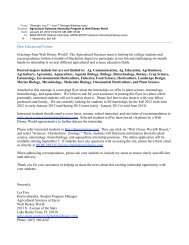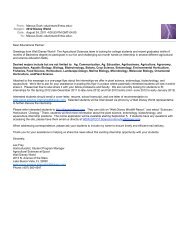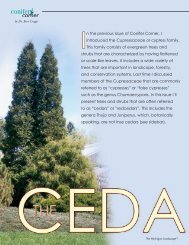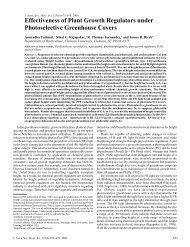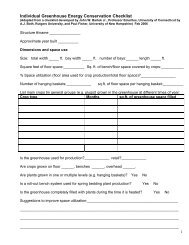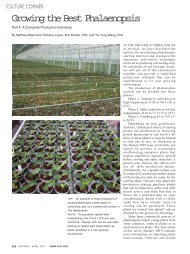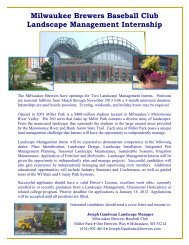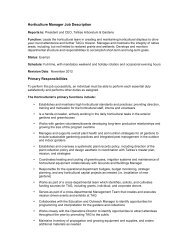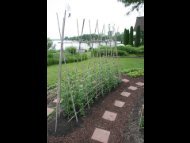Nordmann fir - Department of Horticulture - Michigan State University
Nordmann fir - Department of Horticulture - Michigan State University
Nordmann fir - Department of Horticulture - Michigan State University
You also want an ePaper? Increase the reach of your titles
YUMPU automatically turns print PDFs into web optimized ePapers that Google loves.
volume 2 | number 4 fall 2007survival <strong>of</strong> live christmas treespr<strong>of</strong>ile: nordmann <strong>fir</strong>
This Pot-in-Pot nursery in Denmark produces 90,000 to 100,000container-grown <strong>Nordmann</strong> <strong>fir</strong> each year.Showing the flag. <strong>Nordmann</strong> <strong>fir</strong> are marketed in Europe underthe “Original <strong>Nordmann</strong>” label.Christmas Tree Species Pr<strong>of</strong>ile: <strong>Nordmann</strong> <strong>fir</strong>Abies nordmannianaBy: Bert Cregg, Ph.D. <strong>Michigan</strong> <strong>State</strong> <strong>University</strong>, <strong>Department</strong> <strong>of</strong> <strong>Horticulture</strong> and <strong>Department</strong> <strong>of</strong> ForestryPhotos by Rick Bates, Ph.D. Pennsylvania <strong>State</strong> <strong>University</strong>, <strong>Department</strong> <strong>of</strong> <strong>Horticulture</strong>One <strong>of</strong> the great things about working with Christmas trees is that we get to workwith some beautiful and fascinating plants. Over the years, many species <strong>of</strong> pines,spruces, <strong>fir</strong>s, and even cedars have been used as Christmas trees. Each species hasits unique appeal and every species has a story. Beginning with this issue <strong>of</strong> theGreat Lake Christmas Tree Journal, I will present pr<strong>of</strong>iles <strong>of</strong> interesting Christmas treespecies used in the Great Lakes region and elsewhere. I’ll discuss the basic biology andecology <strong>of</strong> the species, highlight some <strong>of</strong> the advantages or concerns <strong>of</strong> the speciesfor Christmas tree production, and throw in a little trivia or other titillating tidbits.<strong>Nordmann</strong> <strong>fir</strong> Abies nordmannianaBeauty, as they say, is in the eye <strong>of</strong> thebeholder, but few can argue that<strong>Nordmann</strong> <strong>fir</strong> is among the most beautifulconifers found anywhere. Evenfamed plantsman Michael Dirr, who isnot given to feint praise, calls <strong>Nordmann</strong><strong>fir</strong>,“stately, elegant, perhaps the handsomest<strong>of</strong> the <strong>fir</strong>s.” <strong>Nordmann</strong> <strong>fir</strong> is by farthe most popular Christmas tree speciesin Europe and there is increased interestin the species in the United <strong>State</strong>s. Thepopularity <strong>of</strong> this species is due to severalfactors. First and foremost are theglossy, dark green needles, which aredarker than almost any <strong>fir</strong> except forgrand <strong>fir</strong> (Abies grandis). <strong>Nordmann</strong> <strong>fir</strong>needles are directed forward giving the13
nordmann <strong>fir</strong>fall 2007 great lakes christmas tree journal<strong>Nordmann</strong> <strong>fir</strong> is a vigorousgrower under plantationconditions. Europeancustomers, however, donot like sheared trees sogrowers rely on plantgrowth retardants orphloem-wounding toolsto control leader growth.14upper surface <strong>of</strong> the branches a brushed,smooth appearance. There are two distinctwhite bands <strong>of</strong> stomata on theunderside <strong>of</strong> the needles, which producesa silvery effect when the undersides<strong>of</strong> the branches are visible. But theneedles are just part <strong>of</strong> the species’appeal. <strong>Nordmann</strong> <strong>fir</strong> has outstandingsymmetrical form and a relatively openbranch structure with distinct whorls.These traits are valued in the EuropeanChristmas tree market where a layeredappearance and room for candles aredesired. <strong>Nordmann</strong> <strong>fir</strong> is a vigorousgrower under plantation conditions.European customers, however, do notlike sheared trees so growers rely onplant growth retardants or phloemwoundingtools to control leader growth.Extensive research on the genetics <strong>of</strong><strong>Nordmann</strong> <strong>fir</strong> has been conducted inDenmark and the Danes have typicallyfavored the Ambrolauria seed source.However, tree improvement testing forU.S. environmental conditions and culturalpractices is probably warranted.North Carolina <strong>State</strong> <strong>University</strong> geneticistJohn Frampton notes:“Ambrolauria has been widely toutedas the best source <strong>of</strong> <strong>Nordmann</strong> <strong>fir</strong> in theUnited <strong>State</strong>s, however, most Americans<strong>Nordmann</strong> <strong>fir</strong> are marketed as 3–4’ living Christmas trees in Denmark.do not realize that this is based on theEuropean preference for slow growth. Inreality, other faster growing <strong>Nordmann</strong> <strong>fir</strong>sources are likely to be preferable for cultureunder an American shearingregime”. American Christmas TreeJournal 43 (2): 4–11.In its native range, <strong>Nordmann</strong> occurson calcareous soils and therefore maytolerate a wider range <strong>of</strong> pH than other<strong>fir</strong>s. Like most <strong>fir</strong>s, however, <strong>Nordmann</strong><strong>fir</strong> needs adequate drainage for bestcontinued on page 32
nordmann <strong>fir</strong>fall 2007 great lakes christmas tree journalcontinued from page 14growth. Various sources list <strong>Nordmann</strong> <strong>fir</strong>as hardy from zones 4–6 or 4–7. In eithercase, it is well adapted in most <strong>of</strong> lower<strong>Michigan</strong>. In the exotic <strong>fir</strong> species trialinitiated by Dr. Mel Koelling at KelloggForest near Battle Creek, <strong>Nordmann</strong> <strong>fir</strong>has grown well. In addition, the<strong>Nordmann</strong> <strong>fir</strong> trees we transplanted fromKellogg Forest in 2003 continue to dowell at our <strong>Horticulture</strong> ResearchStations in East Lansing, Clarksville, andTraverse City. This broad adaptability suggeststhat <strong>Nordmann</strong> <strong>fir</strong> has significantpotential as a Christmas tree species inmuch <strong>of</strong> <strong>Michigan</strong>. <strong>Nordmann</strong> <strong>fir</strong> alsoresponds well in container production.During the 8th international ChristmasTree Research and Extension Conferencein Denmark (see related article in thisissue <strong>of</strong> Great lakes Christmas TreeJournal), conference participants touredGl. Kirstineberg Planteskole, Europe’sleading producer <strong>of</strong> container-grown<strong>Nordmann</strong> <strong>fir</strong>. The nursery producesapproximately 100,000 three- to four-foottall <strong>Nordmann</strong> <strong>fir</strong>s as living Christmastrees each year. The trees are grown inthree-gallon containers in a Pot-in-Pot systemfor up to four years to reach marketablesize. The Kirstineberg nursery hasworked extensively on their packaging,marketing trees to retail garden centersand as business gifts via direct shipping.Fast Facts on <strong>Nordmann</strong> <strong>fir</strong>:Native range: The native range <strong>of</strong><strong>Nordmann</strong> <strong>fir</strong> forms a crescent along theeast end <strong>of</strong> the Black sea in the mountains<strong>of</strong> Turkey, Georgia and RussianCaucauses. It occurs at elevationsbetween 3000 and 7000 feet in areaswith rainfall in excess <strong>of</strong> 40" per year.Related species: The taxonomy <strong>of</strong> theMediterranean <strong>fir</strong>s is muddled due inpart to wide variation within speciesand also hybridization among species.Turkish <strong>fir</strong> and Trojan <strong>fir</strong> are closelyrelated to <strong>Nordmann</strong> <strong>fir</strong> and are sometimeslisted as separate species (Abies<strong>Nordmann</strong> <strong>fir</strong> (on left) is also an outstanding ornamental tree as shown by this specimenat the MSU Plant and Soil Sciences building. Photo: Bert Cregg.32
nordmann <strong>fir</strong>fall 2007great lakes christmas tree journalMarketing makes it happen. Danish growerswork to establish a brand identify for<strong>Nordmann</strong> <strong>fir</strong>.bornmülleriana and A. equi-trojani,respectively) or as sub-species or varieties<strong>of</strong> Abies nordmanniana.Ornamental cultivars: <strong>Nordmann</strong> <strong>fir</strong> isan outstanding landscape ornamental asa straight species. In addition, theAmerican Conifer Society’s ConiferDatabase (www.conifersociety.org) lists14 named cultivars <strong>of</strong> A. nordmanniana,a handful <strong>of</strong> which are available fromspecialty nurseries. ‘Golden spreader’ is adwarf, spreading form with bright goldfoliage. ‘Tortifolia’ is a conical, intermediategrower (6–12" per year) withupturned needles. ‘Prostrata’ is a prostrate,ground covering form with darkgreen needles.FraserCanaanDouglasConcolorGrandKoreanNobleNordmanTransplantsFir Spruce PineColorado BlueWhiteMeyerSerbianNorwayOrientalWhiteAsk about ourLarge “Power Plug”TransplantsOver 30 Years Nursery ExperienceSource-Identified Seed Containerized & Bareroot262 Wylie School Road, Voluntown, CT 06384860-376-2351 800-508-5099 Fax: 860-376-8963www.treeman2.com35



